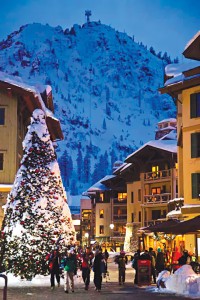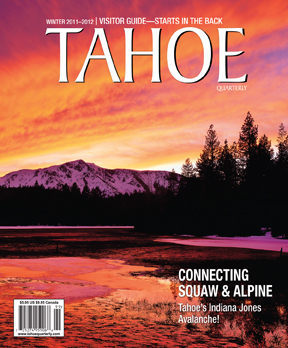Squaw’s Residents Race Against Time, Finances to Incorporate
Written by Tanya Canino
A 30-to-1 scale model intricately details the proposed expansion of the Village at Squaw Valley, with miniature hotels and condos spread across the minutely constructed base of the mountains.
Where the slopes of Red Dog, Olympic Lady and Far East funnel into a snow beach, the model displays three hotels connecting to an adventure center boasting three wet acres of an indoor water park and outdoor pools.
This is one of two models Squaw Valley Real Estate is displaying at the Village’s Base Camp to inform its neighbors and customers about Squaw Valley USA’s transformative plans.
“We have 500 acres of parking lot. This is the redevelopment of those parking lots into a beautiful new, world-class internationally competitive village,” explains Chevis Hosea, Squaw’s vice president of development.
The other model impressively displays phosphorous fiber optics outlining the famed lifts and terrain of Squaw Valley, with Alpine Meadows Ski Area just a valley away, waiting to be linked for skiers although already joined under the ownership umbrella of Denver-based KSL Capital Partners.
“The real message of this model is, when these two mountains are connected, it will be the largest ski resort in the United States. This is more skiable acres than Vail has today. It has the same uphill lift capacity as Whistler Blackcomb. We don’t propose any development at Alpine so this village needs to support both mountains,” Hosea says.
In the future, these models will help sell various types of fractional ownerships, but for now they are the miniature face of a large-scale development.
Each model cost $100,000, ironically the same amount that may be the largest hurdle in the grassroots, community effort to modify the proposed development by incorporating the Olympic Valley—turning it into a self-governed town.
“That’s the most needed part right now,” says Peter Schweitzer, an incorporation organizer. “I think if we raise the money everything else will fall into place.”
Incorporating Olympic Valley—the designated postal name for the valley the 1960 Winter Olympics made famous —began as conversations between residents concerned about a development described as “too much, too soon.” It formalized into an organization last winter and gained steam this summer when Incorporate Placer County Elections Office certified 168 signatures out of 243 submitted, which exceeded the 25 percent requirement to put incorporation on the ballot.
The goal of incorporation is greater authority over land-use planning decisions, organizer Fred Ilfeld recently told the Truckee Chamber membership.
“We see time being of the essence in terms of the very, very large development being planned for our valley,” Ilfeld says.
Town proponents believe it’s not too late for a new city to exert control over the development, citing a 2002 California Supreme Court case regarding the city of Goleta.
“We are an iconic, authentic mountain area ski town with our own unique history and character. We want to preserve it and incorporation is one way of doing so,” Ilfeld says.
Lizzie Day, who attended the 1960 Olympics in her mother’s womb, gathered signatures “three weeks in a row, four days a week, six hours a day,” she says. “When you believe in something and you want to see the integrity of a community kept in place, that donation of time is nothing.”
The signatures were submitted August 20 to the Placer County Local Area Formation Commission (LAFCO), says commission executive officer Kris Berry.
Incorporation supporters will submit an application this fall with a $25,000 deposit—once they raise the money. After that, an economic study will be completed, possibly costing up to $100,000. If LAFCO determines the new city is feasible, then valley residents will vote on it.
“I’m impressed with what they’ve been able to accomplish,” says Ed Heneveld, an emergency room doctor who has lived in the valley for 35 years and favors cityhood.
A preliminary fiscal analysis showed a $310,000 surplus in a $4.74 million budget for the proposed city.
“There are probably not too many places in California that are economically viable for incorporation, but Squaw Valley may be one of those places,” Berry says.
Incorporation cannot have a negative fiscal impact on the rest of North Lake Tahoe and the county as a whole, warned Placer County supervisor Jennifer Montgomery, who represents the eastern part of the county.
“I do have some real concerns about whether the population and dollars make sense,” Montgomery says.
However, incorporating would allow citizens a louder voice in the development of the Olympic Valley. Since the initial development proposal in December 2011, Squaw decided to decrease building heights, restore Squaw Creek, include off-site parking and employee housing, identify an emergency access route and improve parks and recreation, according to a Placer County Planning newsletter.
On July 25, developers notified Placer County they would be making additional changes this fall, says county planner Alex Fisch.
“We don’t know yet because it has to be approved by ownership; we’re looking at a lot of things,” Hosea says.
Some of the considerations include keeping the Squaw Kids building, new configurations for a hotel and the ballroom building, reducing building heights, breaking buildings into smaller volumes, opening areas for better pedestrian ways and mountain views, and revising architectural features.
“We’re not anticipating any downsizing,” Hosea says.
Planned for four phases over 12 to 18-years, the development includes 2,184 bedrooms, Hosea says, a number that is critical to the ski area’s success.
“It’s one of the greatest mountains in the world, put on the map by the 1960 Olympics. It’s kind of lost its world brand because there’s not enough lodging to support the mountain,” Hosea says.
He notes that Whistler Blackcomb has 4,300 lodging units; Vail, 2,800; Aspen/Snowmass, 2,700; Steamboat, 1,900; and Breckenridge, 1,700.
Right now, Squaw Valley has only 1,138 units (a lodging unit is different than bedrooms).
Out of 12,000 skiers in a typical weekend at Squaw Valley, “only 2,000 can get out of bed, click on their skis and go to the mountain,” Hosea said.
Additionally, the planned Grand Camp aquatic center, which includes an “action river” as opposed to a lazy river, is essential to making Squaw a year-round destination resort.
But for many valley residents and Squaw fans, it’s too much.
“Most of the people in Squaw Valley do want some type of destination village that has quality and is integrated with the current village,” says Heneveld.
Covering the parking lot—the asphalt meadow—seems like a good idea, but tearing down the Olympic-era Members Locker Room is heresy. Traffic, noise, construction time, loss of views and light pollution are repeated concerns.
“They are trying to change the entire character. This seems like overkill,” says Laura Hanley, a Bay Area resident who paid original Village developer Intrawest for a premium view that will be lost with the new development.
Heneveld astutely predicts maybe a “Goldilocks” agreement will prevail—“not too much, not too little.”
“What won’t change is the mountain,” Heneveld says. “The challenge will still be there. That’s a comforting thought in all of this.”







